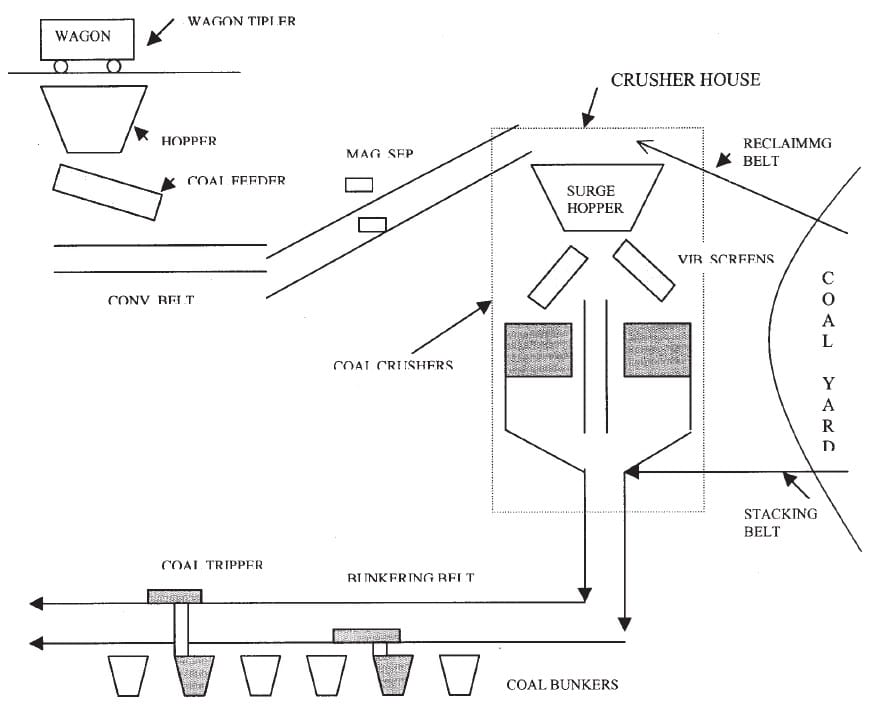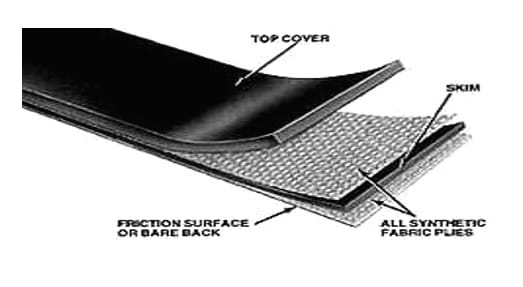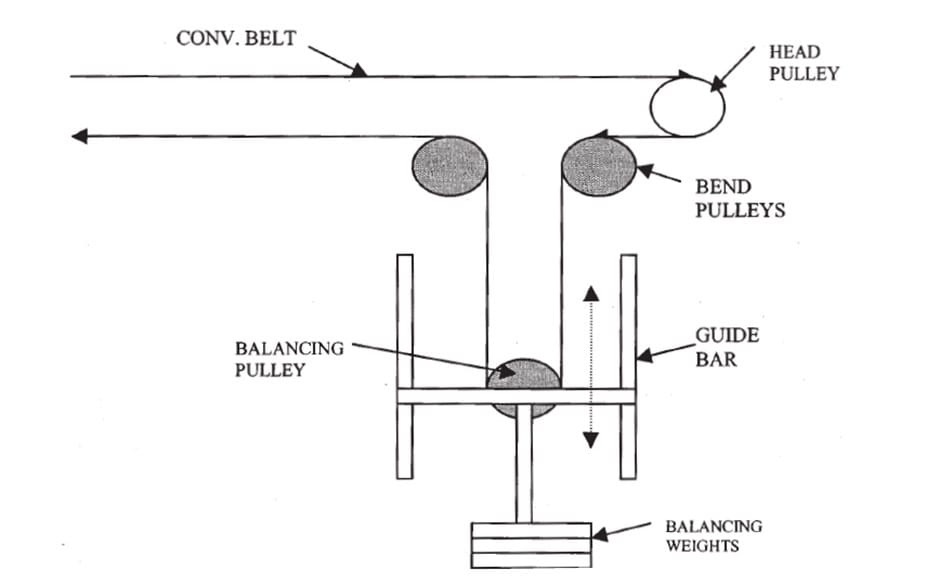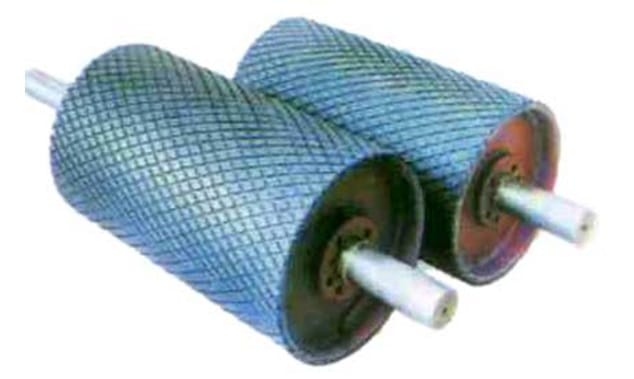Table of Contents
ToggleA coal handling plant (CHP) in a thermal power plant is a facility that receives coal, prepares it for use, and transfers it to the coal bunker. It occupies nearly 50% area of the plant.
The coal is first conveyed to a primary crusher using a combination of conveyor belts, with the feeding rate controlled by electromagnetic vibrating feeders.
A hanging magnet is installed before the crusher to separate ferrous materials, while stones are manually picked up. In the primary crusher, coal is crushed to a size of 100 mm.
The coal is then conveyed to a secondary or final crusher via the belt system. Vibrating screens feed the crushers and bypass coal that is larger than 25 mm. In the final crusher, the coal is crushed to a required size of 25 mm. This crushed coal is sent to the bunkering belt with the help of coal trippers and is finally stored in coal bunkers. This process is called coal bunkering.
When bunkers are full, excess coal is stored in the stockyard using stacking belts or an automatic stacker-cum-reclaimer, a process known as stacking.
In emergencies, if coal supply from railways or ropeways is unavailable, stored coal is reclaimed from the stockyard and sent to the coal bunkers via reclaiming conveyor belts, a process called reclaiming. Coal from the bunkers is then sent to the coal mill for pulverization and combustion in the boiler furnace.

Equipment Used in Coal Handling Plant
Conveyor Belt
These are made from cotton or synthetic fibers with rubber piles in alternating layers, typically between 900 to 1600 mm in width. Key factors considered when selecting a belt include:
- Durability
- Strength
- Toughness
- Elasticity
- Lightness
- Pliability

Belt Tensioning Methods:
- Screw Type: Small horizontal conveyor belts are fitted with a screw-operated gear to adjust belt tension and take up slack. The robust gear is protected from dust and is placed in an accessible location for adjustments and cleaning.
- Automatic Gravity Take-ups: These are provided to maintain slack-side tension, account for belt stretch or shrinkage, eliminate starting jerks, and provide extra length for vulcanizing. The tension is automatically maintained by gravity through a system of pulleys and counterweights.

Rubber Scrapers
Rubber scrapers are installed at the head end of each conveyor to clean off damp coal dust and prevent it from being carried onto the return rollers. These scrapers are kept in contact with the belt through a spring arrangement, preserving the belt and keeping pulleys clean for smooth operation.

Idlers
Idlers prevent sagging of the conveyor belt between the head and tail pulleys by supporting it at intervals. Different types of idlers include:
- Carrying Troughing Idlers: These support the coal load during transport and consist of three rollers forming an arc to prevent sharp bends.
- Return Idlers: These support the empty belt on its return and usually consist of one plain roller for smaller belts or two rollers for wider belts.
Following figure shows carrying troughing idler and return idler.

- Self-Aligning Idlers: These idlers ensure that the belt stays centered during operation. They adjust automatically to correct misalignment, preventing belt damage.
- Impact Idlers: Placed at feeding points, these idlers have rubber-lined rollers to absorb impact and increase the belt’s lifespan.
Pulleys
Conveyor pulleys are typically made of heavy cast iron with machine-crowned faces. The driving pulley is faced with friction material to improve grip. The diameter of the pulley depends on the thickness of the belt, and a general rule of thumb is:
- Head Pulley: 5 * Belt Ply
- Tail Pulley: 4 * Belt Ply
- Snub Pulley: 3 * Belt Ply
- Tripper Pulley: 5 * Belt Ply

Coal Feeders
- Electromagnetic Feeders: Vibrating or jiggling types placed below the coal hopper to feed conveyors without spillage.
- Vibrating Screens: Double-deck screens; the upper deck is a trash screen for larger coal, while the lower deck is a sizing screen for bypassing small coal to the crusher.
Coal Crushers
- Primary Crushers: Hammer or single-roll crushers crush coal from 450 mm to 100 mm.
- Secondary Crushers: Hammer or ring crushers reduce coal to a size of 25 mm.
Trippers
Travelling trippers are used to distribute coal into overhead bunkers. These trippers move along rails and are equipped with a clamping device to secure their position.
Magnetic Separators
Magnetic separators remove tramp iron from coal. There are three types:
- Suspended Magnets: Positioned on the conveyor before the crusher, operated manually.
- Rotating Magnets: A rotating belt passes over the conveyor, removing ferrous materials.
- Magnetic Pulleys: These are installed as head pulleys on conveyors and help remove tramp iron automatically.
Non-magnetic materials such as stones and shells are manually removed from the running belt.
- Coal handling plants play a vital role in ensuring the reliable and efficient operation of power plants.
- From conveyors to crushers and magnetic separators, each component works in harmony to transport, process, and store coal. Proper maintenance of this equipment is essential to minimize operational disruptions and maximize efficiency.
- A well-functioning CHP ensures that coal is delivered to the furnace, providing a steady supply of fuel for power generation.


